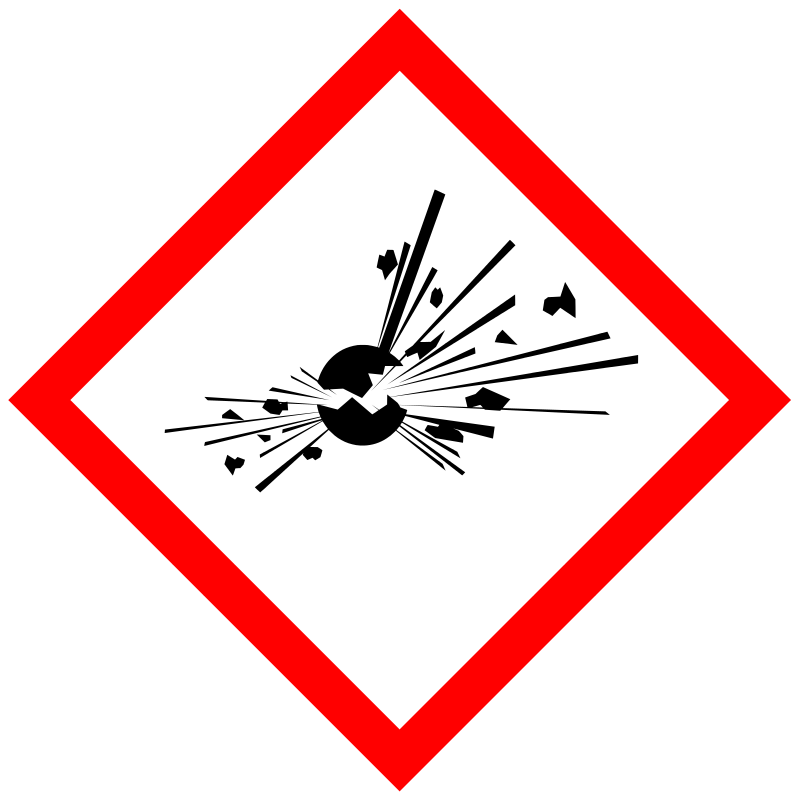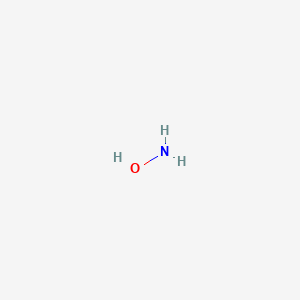D0210 | Nitrogen Oxides
| Pictogram | Signal | Statements | Precautionary Statement Codes |
|---|---|---|---|
     |
Danger |
H200: Unstable Explosive [Danger Explosives] H290: May be corrosive to metals [Warning Corrosive to Metals] H302: Harmful if swallowed [Warning Acute toxicity, oral] H312: Harmful in contact with skin [Warning Acute toxicity, dermal] H315: Causes skin irritation [Warning Skin corrosion/irritation] H317: May cause an allergic skin reaction [Warning Sensitization, Skin] H318: Causes serious eye damage [Danger Serious eye damage/eye irritation] H335: May cause respiratory irritation [Warning Specific target organ toxicity, single exposure Respiratory tract irritation] H351: Suspected of causing cancer [Warning Carcinogenicity] H373 **: Causes damage to organs through prolonged or repeated exposure [Warning Specific target organ toxicity, repeated exposure] H400: Very toxic to aquatic life [Warning Hazardous to the aquatic environment, acute hazard] |
P201, P202, P234, P260, P261, P264, P270, P271, P272, P273, P280, P281, P301+P312, P302+P352, P304+P340, P305+P351+P338, P308+P313, P310, P312, P314, P321, P322, P330, P332+P313, P333+P313, P362, P363, P372, P373, P380, P390, P391, P401, P403+P233, P404, P405, and P501; (The corresponding statement to each P-code can be found at the GHS Classification page.) |
    |
Danger |
H290: May be corrosive to metals [Warning Corrosive to Metals] H302: Harmful if swallowed [Warning Acute toxicity, oral] H312: Harmful in contact with skin [Warning Acute toxicity, dermal] H315: Causes skin irritation [Warning Skin corrosion/irritation] H317: May cause an allergic skin reaction [Warning Sensitization, Skin] H318: Causes serious eye damage [Danger Serious eye damage/eye irritation] H335: May cause respiratory irritation [Warning Specific target organ toxicity, single exposure Respiratory tract irritation] H351: Suspected of causing cancer [Warning Carcinogenicity] H373 **: Causes damage to organs through prolonged or repeated exposure [Warning Specific target organ toxicity, repeated exposure] H400: Very toxic to aquatic life [Warning Hazardous to the aquatic environment, acute hazard] |
P201, P202, P234, P260, P261, P264, P270, P271, P272, P273, P280, P281, P301+P312, P302+P352, P304+P340, P305+P351+P338, P308+P313, P310, P312, P314, P321, P322, P330, P332+P313, P333+P313, P362, P363, P390, P391, P403+P233, P404, P405, and P501; (The corresponding statement to each P-code can be found at the GHS Classification page.) |
     |
Danger |
Aggregated GHS information provided by 513 companies from 19 notifications to the ECHA C&L Inventory. Each notification may be associated with multiple companies. H200 (31.38%): Unstable Explosive [Danger Explosives] H290 (83.82%): May be corrosive to metals [Warning Corrosive to Metals] H302+H312 (13.45%): Harmful if swallowed or in contact with skin [Warning Acute toxicity, oral acute toxicity, dermal] H302 (83.82%): Harmful if swallowed [Warning Acute toxicity, oral] H312 (83.82%): Harmful in contact with skin [Warning Acute toxicity, dermal] H315 (83.82%): Causes skin irritation [Warning Skin corrosion/irritation] H317 (97.66%): May cause an allergic skin reaction [Warning Sensitization, Skin] H318 (97.66%): Causes serious eye damage [Danger Serious eye damage/eye irritation] H335 (83.82%): May cause respiratory irritation [Warning Specific target organ toxicity, single exposure Respiratory tract irritation] H351 (83.63%): Suspected of causing cancer [Warning Carcinogenicity] H373 (85.77%): Causes damage to organs through prolonged or repeated exposure [Warning Specific target organ toxicity, repeated exposure] H400 (98.05%): Very toxic to aquatic life [Warning Hazardous to the aquatic environment, acute hazard] Information may vary between notifications depending on impurities, additives, and other factors. The percentage value in parenthesis indicates the notified classification ratio from companies that provide hazard codes. Only hazard codes with percentage values above 10% are shown. |
P201, P202, P234, P260, P261, P264, P270, P271, P272, P273, P280, P281, P301+P312, P302+P352, P304+P340, P305+P351+P338, P308+P313, P310, P312, P314, P321, P322, P330, P332+P313, P333+P313, P362, P363, P372, P373, P380, P390, P391, P401, P403+P233, P404, P405, and P501; (The corresponding statement to each P-code can be found at the GHS Classification page.) |
    |
Danger |
H290: May be corrosive to metals [Warning Corrosive to Metals] H302: Harmful if swallowed [Warning Acute toxicity, oral] H312: Harmful in contact with skin [Warning Acute toxicity, dermal] H315: Causes skin irritation [Warning Skin corrosion/irritation] H317: May cause an allergic skin reaction [Warning Sensitization, Skin] H318: Causes serious eye damage [Danger Serious eye damage/eye irritation] H335: May cause respiratory irritation [Warning Specific target organ toxicity, single exposure Respiratory tract irritation] H351: Suspected of causing cancer [Warning Carcinogenicity] H372: Causes damage to organs through prolonged or repeated exposure [Danger Specific target organ toxicity, repeated exposure] H400: Very toxic to aquatic life [Warning Hazardous to the aquatic environment, acute hazard] |
P201, P202, P234, P260, P261, P264, P270, P271, P272, P273, P280, P281, P301+P312, P302+P352, P304+P340, P305+P351+P338, P308+P313, P310, P312, P314, P321, P322, P330, P332+P313, P333+P313, P362, P363, P390, P391, P403+P233, P404, P405, and P501; (The corresponding statement to each P-code can be found at the GHS Classification page.) |
    |
Danger |
H290: May be corrosive to metals [Warning Corrosive to Metals] H302: Harmful if swallowed [Warning Acute toxicity, oral] H312: Harmful in contact with skin [Warning Acute toxicity, dermal] H315: Causes skin irritation [Warning Skin corrosion/irritation] H317: May cause an allergic skin reaction [Warning Sensitization, Skin] H318: Causes serious eye damage [Danger Serious eye damage/eye irritation] H335: May cause respiratory irritation [Warning Specific target organ toxicity, single exposure Respiratory tract irritation] H351: Suspected of causing cancer [Warning Carcinogenicity] H373: Causes damage to organs through prolonged or repeated exposure [Warning Specific target organ toxicity, repeated exposure] H400: Very toxic to aquatic life [Warning Hazardous to the aquatic environment, acute hazard] |
P201, P202, P234, P260, P261, P264, P270, P271, P272, P273, P280, P281, P301+P312, P302+P352, P304+P340, P305+P351+P338, P308+P313, P310, P312, P314, P321, P322, P330, P332+P313, P333+P313, P362, P363, P390, P391, P403+P233, P404, P405, and P501; (The corresponding statement to each P-code can be found at the GHS Classification page.) |
   |
Danger |
H315: Causes skin irritation [Warning Skin corrosion/irritation] H317: May cause an allergic skin reaction [Warning Sensitization, Skin] H318: Causes serious eye damage [Danger Serious eye damage/eye irritation] H335: May cause respiratory irritation [Warning Specific target organ toxicity, single exposure Respiratory tract irritation] H371: May cause damage to organs [Warning Specific target organ toxicity, single exposure] H373: Causes damage to organs through prolonged or repeated exposure [Warning Specific target organ toxicity, repeated exposure] |
P260, P261, P264, P270, P271, P272, P280, P302+P352, P304+P340, P305+P351+P338, P309+P311, P310, P312, P314, P321, P332+P313, P333+P313, P362, P363, P403+P233, P405, and P501; (The corresponding statement to each P-code can be found at the GHS Classification page.) |
| (1) hydroxylamine | (hydroxyamino)methanol | 2FFDCFE4-66E9-4869-8F4D-DC8E410797E7 |
| 2FP81O2L9Z | 7803-49-8 | AKOS009031565 |
| AVXURJPOCDRRFD-UHFFFAOYSA-N | BCP03655 | BDBM50082140 |
| C00192 | CCG-204724 | CHEBI:15429 |
| CHEMBL1191361 | CTK2H8929 | CTK8G5726 |
| DB-080981 | DTXSID7041043 | EC 232-259-2 |
| EINECS 232-259-2 | Epitope ID:117722 | FT-0627150 |
| H2N-OH | H2NHO | H2NOH |
| HONH2 | HSDB 579 | HYDROXYAMINE |
| Hydroxylamin | Hydroxylamine (50% solution in water) | Hydroxylamine hydrochloride in combination with isoniazid and rifampicin |
| Hydroxylamine solution, 50 wt. % in H2O | Hydroxylamine solution, 50 wt. % in H2O, 99.999% | Hydroxylaminesolution |
| J-502073 | KS-00000V4I | LS-77353 |
| LS-96747 | Lopac-H-9876 | Lopac0_000637 |
| MCULE-3913133443 | MFCD00044522 | MRF-0000034 |
| N H2 O H | N-hydroxyamine | NCGC00015527-01 |
| NCGC00015527-02 | NCGC00015527-03 | NCGC00162208-01 |
| NH2OH | Nitrinous acid | Nitrogen oxide (NOx) |
| Nitrogen oxides | Nitroxide | Oxammonium |
| Oxyammonia | Q259997 | Q27110260 |
| Q27110261 | SC-51896 | UNII-2FP81O2L9Z |
| [NH2OH] | amine N-oxide | amino alcohol |
| amino-alcohol | arninoalcohol | azinous acid |
| dihydridohydroxidonitrogen | hydroxy amine | hydroxyazanyl |
| hydroxyl amine | hydroxyl-amine | hydroxylamine |
| hyroxylamine |
| CAS Number | 11104-93-1, 124116-74-1, 1242-12-2, 1336-21-6, 13408-29-2, 5470-11-1, 7803-49-8, 82672-09-1 |
| PubChem Compound | 787 |

